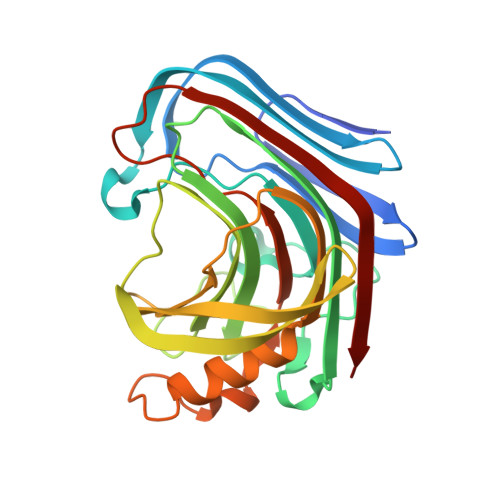Crystal structure and substrate-binding mode of cellulase 12A from Thermotoga maritima
Cheng, Y.-S., Ko, T.-P., Wu, T.-H., Ma, Y., Huang, C.-H., Lai, H.-L., Wang, A.H.-J., Liu, J.-R., Guo, R.-T.(2011) Proteins 79: 1193-1204
- PubMed: 21268113
- DOI: https://doi.org/10.1002/prot.22953
- Primary Citation of Related Structures:
3AMH, 3AMM, 3AMN, 3AMP, 3AMQ - PubMed Abstract:
Cellulases have been used in many applications to treat various carbohydrate-containing materials. Thermotoga maritima cellulase 12A (TmCel12A) belongs to the GH12 family of glycoside hydrolases. It is a β-1,4-endoglucanase that degrades cellulose molecules into smaller fragments, facilitating further utilization of the carbohydrate. Because of its hyperthermophilic nature, the enzyme is especially suitable for industrial applications. Here the crystal structure of TmCel12A was determined by using an active-site mutant E134C and its mercury-containing derivatives. It adopts a β-jellyroll protein fold typical of the GH12-family enzymes, with two curved β-sheets A and B and a central active-site cleft. Structural comparison with other GH12 enzymes shows significant differences, as found in two longer and highly twisted β-strands B8 and B9 and several loops. A unique Loop A3-B3 that contains Arg60 and Tyr61 stabilizes the substrate by hydrogen bonding and stacking, as observed in the complex crystals with cellotetraose and cellobiose. The high-resolution structures allow clear elucidation of the network of interactions between the enzyme and its substrate. The sugar residues bound to the enzyme appear to be more ordered in the -2 and -1 subsites than in the +1, +2 and -3 subsites. In the E134C crystals the bound -1 sugar at the cleavage site consistently show the α-anomeric configuration, implicating an intermediate-like structure.
- Institute of Biotechnology, National Taiwan University, Taiwan.
Organizational Affiliation:


















